
Treasury bonds and bills can be an important part of your investment strategy. However, Treasury yields will determine their value to your portfolio. Treasury yields represent how much profit you earn by buying U.S. Treasury bonds, bills or notes. They can reflect the state of the economy or affect the quality of your mortgage. Before investing, it helps to know how Treasury yields are calculated and how they affect the economy.
If you want to make smart investing choices, a financial advisor can help you create a financial plane to reach your investing goals.
Treasury Yields Explained
The U.S. government often needs to raise capital to build facilities, roads and other infrastructure. It will sell off debt instruments to bring in that money and will often do so with help from the U.S. Treasury. Instruments at the Treasury’s disposal include Treasury bills, Treasury notes and Treasury bonds.
Treasury bills, or T-bills, are bonds that mature within a year. If a short-term investment doesn’t interest you, Treasury bills tend to mature within 10 years or less. Finally, for long-term investors, Treasury bonds mature within 20 to 30 years.
A Treasury yield is how much investors can earn when they purchase one of those government debt obligations. It is the percentage earned on that investment or the interest rate at which the government is borrowing money.
How Treasury Yields Change

The formula for calculating Treasury yields is complicated and changes based on several factors—the bond’s face value, maturity date, purchase price and coupon.
The Federal Reserve Bank of New York notes that yields on Treasury bills require two different methods: The discount yield method and investment yield method. The discount yield formula looks like this:
[(FV – PP)/FV] * [360/M]
In this case FV stands for face value, while PP is purchase price. M is the maturity of the bill, so a six-month Treasury bill would require 182 days. That 360 is the number of days used by banks to determine short-term interest rates. Thus, the discount yield for a 182-day Treasury bill, auctioned at an average price of $9,659.30 per $10,000 face value would be 6.74%.
The investment yield method is based calendar years, so 360 days would be replaced by 365 days or 366 in leap years. Using the same Treasury bill from the example above, the Treasury yield would ab 7.07%.
The formula for bonds and notes is a bit more complex:
[C + ((FV – PP) / M)] ÷ [(FV + PP)/2]
In this formula, the C stands for the coupon rate, while the face value, purchase price and maturity all remain the same. If the Treasury issued a 7-year note with a $100 face value with a 7.875% coupon rate that sold at an average of $99.709, the Treasury yield would be 7.93%.
Why Treasury Yields Matter

Treasury yields can indicate the overall state of the stock market and the general economy. For example, changes in Treasury yields can affect the rise and fall of other interest rates, including mortgage interest rates, auto loans and business loans.
Yields have a see-saw affect on these rates. When the demand for bonds goes up, interest rates tend to go down. And when the demand for bonds goes down, interest rates tend to rise. This happens because an increase in demand will also increase the price and lower the yield and interest rates.
Treasury rates generally signify the level of investor confidence. When confidence in the market is low, buyers tend to gravitate toward safer investments like Treasuries. Thus, the demand for Treasury bonds increases. When investor confidence is high, buyers may take on riskier investments and lower demand for government-backed securities.
You should also note that depending on how yields affect interest rates, borrowing money can become more expensive or cheaper. And this in turn can have a rippling effect on the value of your stock and the rate of return on your investment. So a change in the Treasury yield might be a signal to re-determine the fair value of your stock and re-assess the risk of your investment.
Experts have long looked at the 10-year U.S. Treasury yield as a benchmark of the state of the economy.
Bottom Line
While yields represent the return on investment when buying government-backed debt securities such as a Treasury bond, they are important to the financial world for many reasons. They also affect interest rates in other areas of the market, such as mortgage interest rates. And perhaps more importantly, they can be good indicators of the state of the market and investor confidence.
Bond Tips
- If you’re considering adding Treasury bonds to your portfolio, figuring out Treasury yields can be useful. A financial advisor can help you with that. Finding a qualified financial advisor doesn’t have to be hard. SmartAsset’s free tool matches you with up to three financial advisors who serve your area, and you can interview your advisor matches at no cost to decide which one is right for you. If you’re ready to find an advisor who can help you achieve your financial goals, get started now.
- There are other bonds out there that can be sound investments if Treasury bonds aren’t the right fit. The SmartAsset bond buying guide can help you find relatively safe places to put your hard-earned cash.
Photo credit: ©iStock.com/outline205, ©iStock.com/izusek, ©iStock.com/ipopba